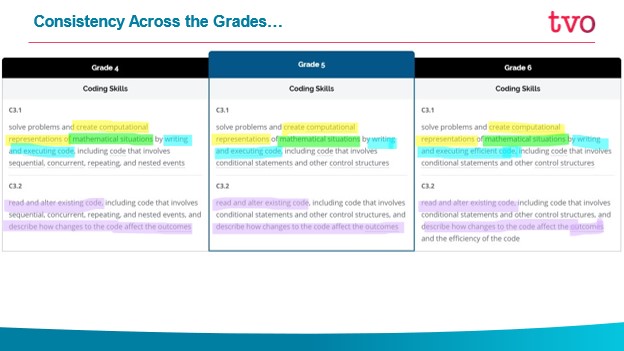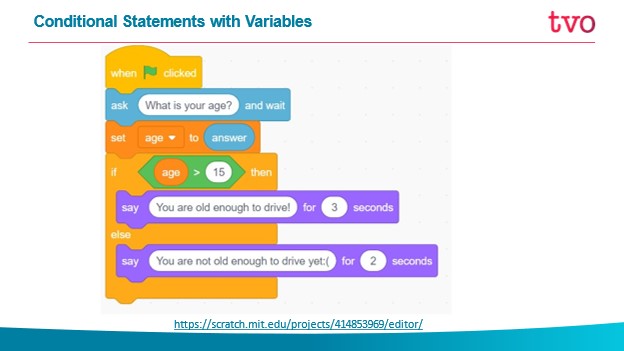The following webinar was presented on Wednesday, April 21st, 2021.
Join Lisa Anne Floyd as she shares math and coding ideas that can be incorporated into junior classrooms. Coding examples and assessment task ideas will be highlighted as the curriculum expectations for grades 4-6 are described and explored. The goal of this webinar is to build educators’ understanding and confidence with connecting to the Coding Expectations, through a Cross Strand approach, in the new Ontario Grades 1-8 Mathematics Curriculum.
The recording of this webinar is below:
School boards might find it helpful to share this link with educators as part of professional development.
Some of the resources, including links to programs, teacher guides and student activities shared in the webinar are highlighted below.
The continuum of skills from grades 4 to 6 include:
- Nested events introduced in grade 4
- Conditional Statements introduced in grade 5
- Efficiency of code, which is the focus of grade 6
The skills across the grades build in complexity.
Nested Events – Grade 4
A great way to introduce nested events, which are introduced in grade 4, is through creating images that incorporate 2D shapes. Such images were created in a math and programming learning language called Logo by Seymour Papert and students in the 1980s!
Below is a sample activity to introduce students to drawing shapes in Scratch:

You can see we started with pre-existing code:
https://scratch.mit.edu/projects/428762466/editor/
Students can click on the green flag to see what happens. They might alter the code and check out how their changes impact the outcome. Possible solutions to the suggested challenges can be seen in the video below.
Once students draw shapes, they can be challenged to draw a circle of shapes, which requires them to make use of a repeat inside of another repeat. This is an example of a nested event:
If you’re interested in having your students create these shapes on their own, here are some videos for support, courtesy of my son Maxwell:
Making a square:
Making other shapes:
Circle of squares (nested events):
Although there are new skills that are introduced in each grade, there is also some consistency across the grades. This was highlighted in the webinar and shown below:

Conditional Statements – Grade 5
In Grade 5, conditional statements are introduced and an explanation of these is provided in the webinar.
A simple Scratch program for demonstrating conditional statements without variables was shared. In this program, we also see a nice application of the Cartesian Plane with the arrow keys and adjusting of the x and y coordinate values.
When Scratch moves over various colours, a label appears (grass, ground and sky):
https://scratch.mit.edu/projects/519138609/editor/

Conditional Statements often incorporate variables. Variables are described in the webinar as well as in our teacher guide and student activity posted here:
The student activity, which can be shared with students online or onsite, introduces students to variables and conditional statements by having them create an Addition program and an Addition Game. Questions and extensions are provided, as well as solutions.
In this student activity, students will create two applications by following video tutorials. Screen prints of these two applications are shared below:


Another basic introduction to conditional statements shared in the webinar incorporates a Scratch application that tells the user whether or not they are old enough to drive based on their age.
The existing code can be shared with students, and they can first determine how it works, and then be challenged to alter the code so that it will indicate whether or not the user is old enough to vote.
Here’s the link to this program that you might share with students:
https://scratch.mit.edu/projects/414853969/editor/

Data – Probability and Conditional Statements
Probability provides a great way to incorporate conditional statements while connecting to the Data strands. Here are some of the programs shared:
Screen print of basic coin flipper in Scratch:

Here’s the program altered to include an experimental probability calculation:
https://scratch.mit.edu/projects/512518395/editor/
Perhaps students might alter the code to generate more data – and to demonstrate that the higher the number of flips we generate, the closer the experimental probability will come to the theoretical probability. This provides a great connection to grade 4 and 5 Data expectations, as described in the webinar! Students will need to incorporate repeats for this challenge and may also switch to Turbo mode (under Edit) in Scratch.
A similar coin flipping application example was shared for MakeCode which is a code editor that can be used for micro:bit:
https://makecode.microbit.org/_13H0LxRzaFk5
In this application, the micro:bit will display an H or a T when it is shaken, and the number of heads, tails and total flips is recorded. This information can be displayed when the user presses the A, B or AB buttons together. When the micro:bit is tilted, a bar graph will display the experimental probability for heads.

Financial Literacy
The following program connects to grade 5 Financial Literacy while also incorporating conditional statements. This program is a little more challenging. It asks the user for the price and number of items for two products, calculates the unit rate for each, and then indicates which is the better value:
https://scratch.mit.edu/projects/512532493/editor/
Efficiency of Code – Grade 6
In grade 6, students are expected to write and execute efficient code. In this screen print, two different ways for drawing a triangle is shown. Students can discuss which code is more efficient and why.

Link to Scratch Program: https://scratch.mit.edu/projects/476514366/editor/
Assessment Ideas
Finally, slides that contain assessment ideas that vary in complexity for grades 4-6 were shared:

https://docs.google.com/presentation/d/1mFLtaL1UjtOEN85eqhiWU07cvdqHuPn098iIKdHxawc/edit?usp=sharing
Thank you for viewing this webinar. Hopefully, this provides you with a solid starting point to explore the new curriculum expectations in the junior grades. There is so much more you can do, and with experience and time, you will continue to learn and build your confidence with coding in mathematics.
If you have any questions, please connect with Lisa Anne: [email protected], Maureen: [email protected] or [email protected]
Be sure to check our Intermediate Math and Coding Webinar.
The primary webinar recording and resources can be found here.
Keep in mind, we are always looking to create and share resources that support educators in Ontario. If you have a request or an idea, please let us know!